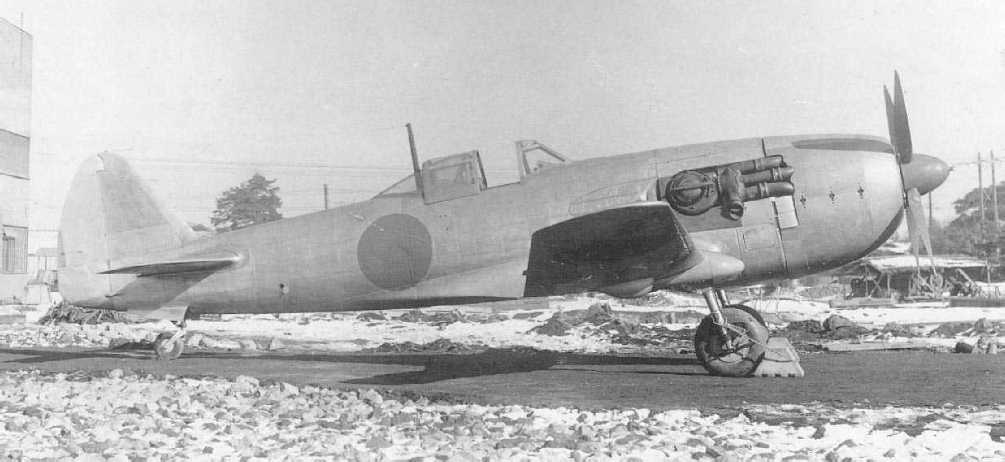Nakajima Ki-87 on:
[Wikipedia]
[Google]
[Amazon]
The Nakajima Ki-87 was a Japanese high-altitude fighter-

Information (Japanese) plus illustration by Shigeo Koike
{{Japanese Army Aircraft Designation System Ki-087, Nakajima 1940s Japanese experimental aircraft Low-wing aircraft Ki-087 Single-engined tractor aircraft Aircraft first flown in 1945
interceptor
Interceptor may refer to:
Vehicles
* Interceptor aircraft (or simply "interceptor"), a type of point defense fighter aircraft designed specifically to intercept and destroy enemy aircraft
* Ford Crown Victoria Police Interceptor, a police car
* ...
of World War II. It was a single seat, exhaust-driven turbo-supercharged engined, low-wing monoplane with a conventional undercarriage
Conventional landing gear, or tailwheel-type landing gear, is an aircraft undercarriage consisting of two main wheels forward of the center of gravity and a small wheel or skid to support the tail.Crane, Dale: ''Dictionary of Aeronautical Term ...
.
Design and development
The Ki-87 was developed in response to American B-29 Superfortress raids on the Home Islands. It followed up on earlier research by Nakajima and the Technical Division of Imperial Army Headquarters into boosting a large radial engine with an exhaust-driven turbo-supercharger, which had begun in 1942, well before the B-29 raids began. The efforts of the Technical Division of Imperial Army Headquarters eventually culminated into the Tachikawa Ki-94-I, while the Ki-87 was developed as a fall-back project, using less stringent requirements. Nakajima started in July 1943 with the construction of three prototypes, to be completed between November 1944 and January 1945, and seven pre-production aircraft, to be delivered by April 1945. The Technical Division of Imperial Army Headquarters made itself felt during the development of the Ki-87 prototype when they insisted upon placing the turbo-supercharger in the rear-fuselage, and from the sixth prototype the Nakajima fighter was to have that arrangement. The Ki-87 had a rearward folding undercarriage to accommodate the storage of ammunition for the cannons, which were mounted in the wing. Construction was delayed due to problems with the electrical undercarriage and the turbo-supercharger, and the firstprototype
A prototype is an early sample, model, or release of a product built to test a concept or process. It is a term used in a variety of contexts, including semantics, design, electronics, and Software prototyping, software programming. A prototyp ...
was not completed until February 1945; it first flew in April, but only five test flights were completed, all with the undercarriage in the extended position.
A further variant, the Ki-87-II, powered by a 3,000 hp Nakajima Ha217 (Ha-46) engine and with the turbo-supercharger in the same position as the P-47 Thunderbolt, never went further than the drawing board.
Operational history
Production of 500 aircraft was planned, but the war ended before any more than the single prototype were built.Aircraft markings
The sole completed prototype was in natural metal finish; some paintings show a black anti-glare area in front of thecockpit
A cockpit or flight deck is the area, usually near the front of an aircraft or spacecraft, from which a Pilot in command, pilot controls the aircraft.
The cockpit of an aircraft contains flight instruments on an instrument panel, and the ...
, but this is not seen on any of the known photographs of the plane. However, James P. Gallagher took a photo of the Ki-87 at the abandoned Japanese Army fighter base at Chofu after Japan's surrender. The photo clearly shows a black anti-glare area from the cockpit forward to the tip of the nose.James P. Gallagher, ''With the Fifth Army Air Force: Photos From the Pacific Theater'' (2001; Johns Hopkins University Press, Baltimore)
Specifications (Ki-87 prototype)

See also
References
;Notes ;Bibliography * (new edition 1987 by Putnam Aeronautical Books, .) * * * Unknown Author ''Famous Aircraft of the World, first series, no.76: Japanese Army Experimental Fighters (1)''. Japan: Bunrin-Do Co. Ltd., August 1976.External links
Information (Japanese) plus illustration by Shigeo Koike
{{Japanese Army Aircraft Designation System Ki-087, Nakajima 1940s Japanese experimental aircraft Low-wing aircraft Ki-087 Single-engined tractor aircraft Aircraft first flown in 1945